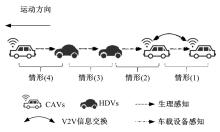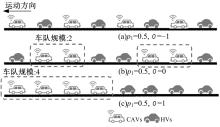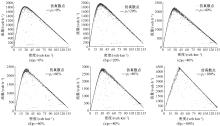吉林大学学报(工学版) ›› 2023, Vol. 53 ›› Issue (2): 405-412.doi: 10.13229/j.cnki.jdxbgxb20210680
考虑智能网联车队强度的混合交通流基本图模型
- 1.同济大学 道路与交通工程教育部重点实验室,上海 201804
2.西南交通大学 交通运输与物流学院,成都 610031
Fundamental diagram model of mixed traffic flow of connected and automated vehicles considering vehicles degradations and platooning intensity
Rui-fa LUO1( ),Hui-jun HAO2,Tao-rang XU2,Qiu-fan GU2
),Hui-jun HAO2,Tao-rang XU2,Qiu-fan GU2
- 1.Key Laboratory of Road and Traffic Engineering,Ministry of Education,Tongji University,Shanghai 201804,China
2.School of Transportation and Logistics,Southwest Jiaotong University,Chengdu 610031,China
摘要:
随着智能网联车的发展和普及,在未来较长时段内,道路上的交通流内将过渡为由智能网联车和人工驾驶车组成的混合交通流。为揭示此类混合交通流流量、密度、速度三者之间的关系,本文以考虑智能网联车功能退化和车队强度为出发点,建立了智能网联环境下的混合交通流基本图模型。首先,对智能网联车退化后产生的不同类型车辆分别采用特定的跟驰模型进行模拟,并确定了车队强度影响下不同类型车辆的比例;基于此,推导出同时考虑车辆功能退化与车队强度的基本图模型,以弥补已有研究未全面考虑二者的不足,使构建的模型更符合混合交通流实际情形;最后,通过设计SUMO仿真实验进行验证。仿真结果表明:不同场景下仿真获得的流量-密度散点与对应理论曲线的一致性较高,从而验证了理论模型的正确性。
中图分类号:
- U463.6
| 1 | 刘爽, 吴韶波. V2X车联网关键技术及应用[J]. 物联网技术, 2018, 8(10): 39-40, 43. |
| Liu Shuang, Wu Shao-bo. Key technologies and applications of V2X internet of vehicles [J]. Internet of Things Technology, 2018, 8(10): 39-40, 43. | |
| 2 | Bansal P, Kockelman K M. Forecasting Americans' long-term adoption of connected and autonomous vehicle technologies[J]. Transportation Research, Part A: Policy and Practice, 2017, 95(1): 49-63. |
| 3 | Calvert S C A, Schakel W J, Lint J W C V. Will automated vehicles negatively impact traffic flow?[J]. Journal of Advanced Transportation,2017, 2017: 3082781. |
| 4 | Talebpour A, Mahmassani H S. Influence of connected and autonomous vehicles on traffic flow stability and throughput[J]. Transportation Research, Part C: Emerging Technologies, 2016, 71: 143-163. |
| 5 | Ye L, Yamamoto T.Modeling connected and autonomous vehicles in heterogeneous traffic flow[J]. Physica A: Statistical Mechanics and its Applications, 2018, 490: 269-277. |
| 6 | Yao Z, Hu R, Wang Y, et al. Stability analysis and the fundamental diagram for mixed connected automated and human-driven vehicles[J]. Physica A: Statistical Mechanics and its Applications, 2019, 533: 121931. |
| 7 | Wang M, Treiber M, Daamen W, et al. Modelling supported driving as an optimal control cycle: framework and model characteristics[J]. Transportation Research, Part C: Emerging Technologies, 2013, 36: 547-563. |
| 8 | 秦严严, 王昊, 王炜, 等. 混有协同自适应巡航控制车辆的异质交通流稳定性解析与基本图模型[J]. 物理学报, 2017, 66(9): 257-265. |
| Qin Yan-yan, Wang Hao, Wang Wei, et al. Heterogeneous traffic flow stability analysis and fundamental diagram model of mixed adaptive cruise control vehicles[J]. The Physica Journal, 2017, 66(9): 257-265. | |
| 9 | Zhou J, Zhu F. Modeling the fundamental diagram of mixed human-driven and connected automated vehicles-ScienceDirect[J]. Transportation Research, Part C: Emerging Technologies, 2020, 115: 102614. |
| 10 | 秦严严, 王昊, 王炜, 等. 混有CACC车辆和ACC车辆的异质交通流基本图模型[J]. 中国公路学报, 2017, 30(10): 127-136. |
| Qin Yan-yan, Wang Hao, Wang Wei, et al. Fundamental diagram model of heterogeneous traffic flow mixed with cooperative adaptive cruise control vehicles and adaptive cruise control vehicles[J]. China Journal of Highway and Transport, 2017, 30(10): 127-136. | |
| 11 | 常鑫, 李海舰, 荣建, 等. 混有智能网联车队的交通流基本图模型分析[J]. 东南大学学报: 自然科学版, 2020, 50(4): 782-788. |
| Chang Xin, Li Hai-jian, Rong Jian, et al. Analysis on fundamental diagram model for mixed traffic flow with connected vehicle platoons[J]. Journal of Southeast University(Natural Science Edition), 2020, 50(4): 782-788. | |
| 12 | Levin M W, Boyles S D. A multiclass cell transmission model for shared human and autonomous vehicle roads[J]. Transportation Research, Part C: Emerging Technologies, 2016, 62: 103-116. |
| 13 | 徐桃让, 姚志洪, 蒋阳升, 等. 智能网联车环境下考虑反应时间影响的基本图模型[J]. 公路交通科技, 2020, 37(8): 108-117. |
| Xu Tao-rang, Yao Zhi-hong, Jiang Yang-sheng, et al. The fundamental diagram model considering the influence of reaction time of mixed traffic flow of connected and automated vehicles[J]. Journal of Highway and Transportation Research and Development, 2020, 37(8): 108-117. | |
| 14 | Baskar L D, Schutter B D, Hellendoorn J. Optimal routing for intelligent vehicle highway systems using a macroscopic traffic flow model[C]∥International IEEE Conference on Intelligent Transportation Systems, St.Louis, USA, 2009: 10964900. |
| 15 | 秦严严,王昊.自动驾驶车辆交通流基本图与驾驶舒适性[C]∥第十三届中国智能交通年会大会论文集, 天津, 中国, 2018: 280-288. |
| 16 | Bose A, Ioannou P. Mixed manual/semi-automated traffic: a macroscopic analysis[J]. Transportation Research, Part C: Emerging Technologies, 2003, 11(6): 439-462. |
| 17 | Ghiasi A, Hussain O, Qian Z S, et al. A mixed traffic capacity analysis and lane management model for connected automated vehicles: a Markov chain method[J]. Transportation Research, Part B: Methodological, 2017, 106(11): 266-292. |
| 18 | Xie D, Zhao X, He Z. Heterogeneous traffic mixing regular and connected vehicles: modeling and stabilization[J]. IEEE Transactions on Intelligent Transportation Systems, 2019, 20(6): 2060-2071. |
| 19 | Jia D, Ngoduy D, Vu H L. A multiclass microscopic model for heterogeneous platoon with vehicle-to-vehicle communication[J].Transportmetrica B,2019,7(1): 448-472. |
| 20 | Milanes V, Shladover S E, Spring J, et al. Cooperative adaptive cruise control in real traffic situations[J]. IEEE Transactions on Intelligent Transportation Systems, 2014, 15(1): 296-305. |
| 21 | Shladover S, Su D, Lu X Y. Impacts of cooperative adaptive cruise control on freeway traffic flow[J]. Transportation Research Record Journal of the Transportation Research Board, 2012(2324): 63-70. |
| 22 | Zheng F F, Liu C, Liu X B, et al. Analyzing the impact of automated vehicles on uncertainty and stability of the mixed traffic flow-science direct[J].Transportation Research, Part C: Emerging Technologies, 2020, 112: 203-219. |
| 23 | 杨顺,蒋渊德,吴坚,等.基于多类型传感数据的自动驾驶深度强化学习方法[J].吉林大学学报:工学版, 2019, 49(4): 1026-1033. |
| Yang Shun, Jiang Yuan-de, Wu Jian, et al. Autonomous driving policy learning based on deep reinforcement learning and multi-type sensor data[J]. Journal of Jilin University(Engineering and Technology Edition), 2019, 49(4): 1026-1033. | |
| 24 | 贾彦峰, 曲大义, 林璐, 等. 基于运行轨迹的网联混合车流速度协调控制[J]. 吉林大学学报: 工学版, 2021, 51(6): 2051-2060. |
| Jia Yan-feng, Qu Da-yi, Lin Lu, et al. Coordinated speed control of connected mixed traffic flow based on trajectory[J]. Journal of Jilin University(Engineering and Technology Edition), 2021, 51(6): 2051-2060. |
| [1] | 魏丽英, 吴荣华, 王志龙, 朱建辉. 基于混合交通流的车辆换道行为[J]. 吉林大学学报(工学版), 2014, 44(5): 1321-1326. |
| [2] | 魏巍, 李志慧, 赵永华, 曲昭伟, 江晟, 柴婷婷. 基于智能相机的混合交通流检测方法[J]. 吉林大学学报(工学版), 2013, 43(04): 866-870. |
| [3] | 刘泓, 王慧, 沈逢春. 基于混合交通流下的交叉口延误[J]. 吉林大学学报(工学版), 2011, 41(增刊1): 72-75. |
| [4] | 江晟, 王殿海, 赵莹莹, 魏巍. 基于复合算法的混合交通流前景提取[J]. 吉林大学学报(工学版), 2011, 41(增刊1): 76-80. |
| [5] | 刘明君1, 2,孙全欣2, 高利平3,陈振起4, 毛保华2. 基于风险分析方法的首车疏解车头时距[J]. 吉林大学学报(工学版), 2011, 41(05): 1262-1267. |
|









